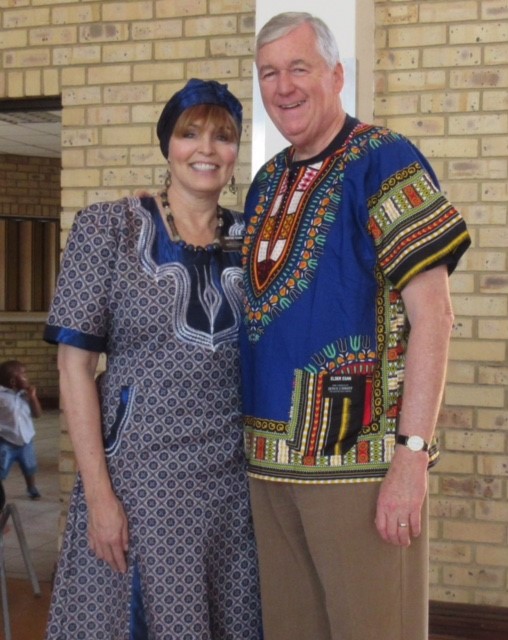As far as the food... Ethiopians eat injera (a thin sourdough flatbread, like a tortilla but spongy, made from teff flour, pronounced in-JEER-uh) three meals a day and use no eating utensils. And every meal begins with a coffee ceremony with burning incense on the table and a hand-washing ceremony, where the host pours water from a pitcher into a bowl, along with soap, so each person, one at a time, around the table, gets his/her hands washed.
At the restaurant, following the coffee and hand-washing ceremonies, they brought us two covered pans of injera (see below) and set them on very low tables, near our feet.
The basket-like covers were taken off to reveal round pans of injera, 20 inches in diameter plus rolls of injera, both white and brown, that you can unroll like gauze. You eat only with your right hand using pieces of injera, torn from the round piece or the roll, to pick up bites of the entrees, called wat (pronounced WOT).
Then they spoon the entrees, different kinds of wat, onto the injera. Wat is made by simmering chopped red onions in a pot, adding vegetable oil and spices such as berbere or turmeric and vegetables and/or meat to form various types of stews. The meat could be beef (sega wat), chicken (doro wat), goat or lamb (beg wat), fish (asa wat), etc. or the wat could be vegetarian, using lentils, chick peas or other vegetables.
Among the most popular wat seemed to be the burbere (prounounced like BUR-bury) with ground beef (the red one in the center of the injera, which tasted like it was heavily seasoned with chili powder). To the left and right of the red one (the yellow and orange) were chick peas in different spices, the one on the right being called shiro, and around the injera were various other meat and vegetable wats. We all ate from the same pans using injera between the thumb, index and middle fingers of our right hands to pick up the wat. There's much more to it than this, but you get the idea. Some wats were spicier than others, some were tasty and some less so, at least to our palates! It was a filling and satisfying meal.
As we were eating, the music from the nine regions of Ethiopia, continued, with 3 male and 3 female dancers in colorful costumes and different female and male singers adding the vocals. We were there over two hours and had only heard music from 5 of the 9 regions, the 5th one alone had to last close to a half-hour! Very fun and fascinating, but our group was pretty tired of the music and dancing by then and felt like we had all put in a long day. So we went back to the Hotel Sidra for final visiting and goodbyes.
Our quick visit to Ethiopia was an incredible experience and we can't believe how much we saw in about 36 hours. We survived the jetlag and enjoyed being with Bob's sister and her husband, who will soon complete their mission and return home Tuesday. His brother Rick left a day or two after we did.
From Addis Ababa, we flew 5 hours back to Johannesburg, had a 2-hour layover, and flew two more hours to Cape Town at the southern tip of Africa. Our next posting will be from Cape Town.







No comments:
Post a Comment